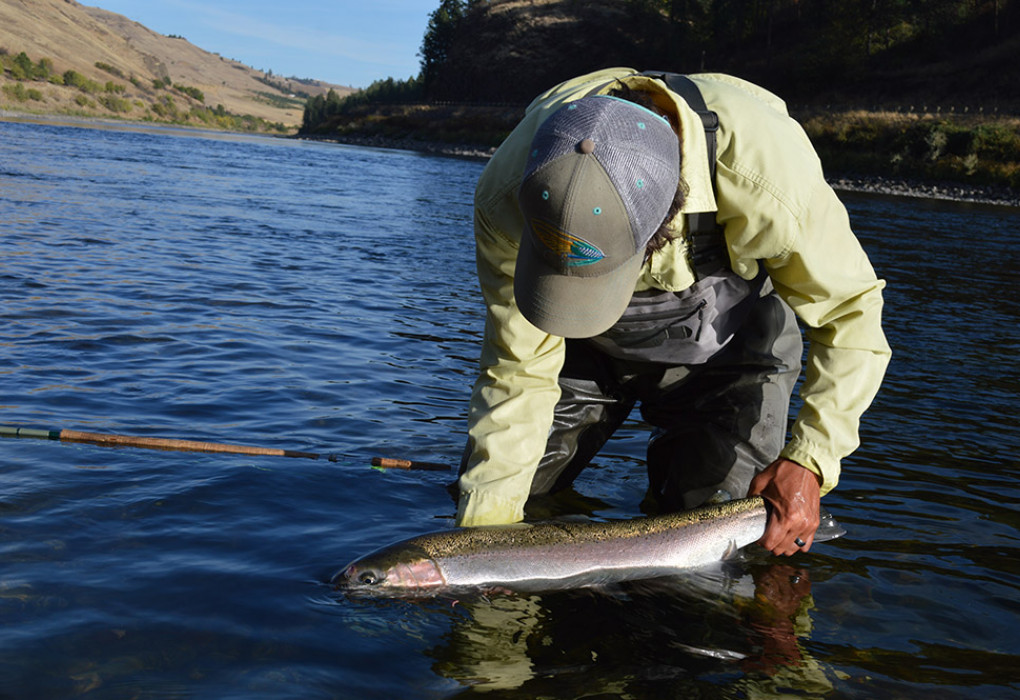Save the Bs, Save the Columbia
Save the Bs, Save the Columbia
Of the Columbia River's many runs of salmon and steelhead, there are particular fish species whose lives are so difficult and complex that they magnify the shortcomings of our current efforts to save the Columbia's wild salmon and steelhead. Once such run is the wild B-run steelhead, a subset of the Snake River, Upper Columbia and Mid-Columbia steelhead runs, which are distinguished by their large size (31 inches or larger), the result of spending more time at sea.
Most wild B-run steelhead are attempting a 1,000 mile round trip from Idaho to the Pacific and back. Their journey includes passing 8 large dams in the Columbia and Snake rivers not once but twice -- first as little 8 inch juvenile steelhead and again as adults! Simply put wild B-run steelhead are a pain in the rear for fish managers and dam operators. They stay too long in freshwater when they’re young, spend too much time in the Pacific putting on weight, return to their rivers too early in the summer, co-mingle with more abundant runs like fall chinook on their return, and then wait around too long to spawn. Almost every part of their life has been made more difficult by the changes that have occurred in the Columbia and Snake rivers over the past 100 years.
The Idaho Department of Fish and Game estimates that there are currently 6,400 miles of spawning and rearing habitat available to B-run steelhead in Idaho. This is enough habitat to support an estimated 33,000 wild B-run fish. But from 1984 to 2008, the average B-run return was ~ 10,000 wild fish. And this year, fisheries managers have forecasted that just 1,100 wild B-runs will return to Bonneville Dam. By the time they reach Lower Granite Dam, that number shrinks to just 865 wild B-run steelhead as a result of crossing dams and navigating the Columbia’s many fisheries.
Why are there so few wild B-run steelhead?
The primary reason there are so few B-run steelhead is that much of the spawning habitat in Idaho goes unseeded. Wild steelhead are simply not surviving from Idaho to the Pacific and back again to spawn.
CONCRETE CHALLENGES
Dams - specifically the four lower Snake River dams - are a significant factor. In 2015, with low snowpack and warm water in the rest of the Snake, juvenile steelhead struggled to survive on their way to the ocean, especially when crossing the long pools of slack water behind the dams.
In response, Judge Michael Simon ordered increased spill at Columbia and Snake river dams for 2017. Simon also ordered the National Marine Fisheries Service to review Snake River dam removal in their revised Biological Opinion on the impacts of the Columbia River’s 12 dams on threatened fish.
Apart from the lower four Snake River dams, Dworshak Dam, which blocks the once famous North Fork of the Clearwater River, is the most notorious impact to Idaho’s wild B-run steelhead. Built in 1973 by the US Corps of Engineers for a $373 million, to generate power and store water, Dworshak is the U.S.’s third tallest dam, too tall to provide fish passage. Instead, the Dworshak National Fish Hatchery was constructed for $21 million and annually releases 2.3 million young hatchery steelhead as mitigation. The hatchery’s goal is to return 30,000 steelhead to the Columbia, of which 20,000 end up in the Clearwater. In the process, Idaho wiped out a run of some of the largest wild steelhead on the planet and the Clearwater’s wild runs have shrunk dramatically -- as recently as the 1960s, 60,000 wild steelhead returned to the Clearwater alone. In spite of a large crack in Dworshak's infamous structure, near-term dam removal remains unlikely.
Commercial and recreational fisheries in the Columbia River also pose a threat to wild, B-run steelhead. A 2004 study conducted by Idaho Fish and Game found that 55% of the B-run steelhead crossing Bonneville Dam were caught or missing. This year, with just 1,100 wild B-run steelhead expected to cross Bonneville Dam, that level of impact would be disastrous.
According to the Endangered Species Act, commercial and recreational fisheries can only impact 2% of the wild B-run. In 2017, this represents just 22 fish that can be lost to fisheries over 400 river miles. Oregon and Washington Departments of Fish and Wildlife have hosted public meetings to discuss possible regulation changes. They have been poring over management models to determine how to reduce angling impact but it’s difficult to project with high confidence where “savings” will occur when the margin for error is so thin.
IMPROVING FISHERIES
One way to protect these wild B-run steelhead in 2017 is by supporting special angling regulations for sport and commercial fisheries in the Columbia River and its tributaries. Though ODFW and WDFW are considering additional angling regulations, we’re concerned their recommendations are not protective enough. To ensure the B-runs safely reach their spawning grounds, Native Fish Society recommends the following regulations for all sport and commercial fisheries. (To sign the action alert click the button in the upper left hand corner of this post.)
RECREATIONAL ANGLING RECOMMENDATIONS FOR OREGON & WASHINGTON WATERS
1. Rolling steelhead fishery closures. Close the Columbia River to all steelhead angling (both retention of hatchery fish and catch and release of wild steelhead) in correspondence with the 2017 run timing of B-run steelhead.
2. Close known cold-water refuges to all angling.
Below Bonneville Dam: Close creeks and cold water pools in the Columbia from Bridal Veil, Multnomah, Horsetail, Tanner, and Lawton Creeks and lower 1/2 mile of Cowlitz and Lewis rivers June 16 through October 2017.
Above Bonneville Dam: Close Herman and Eagle creeks and their cold water pools in the Columbia from June 16 through December. Close lower 1 mile of Wind, Little White, Drano Lake, White Salmon, Hood, Klickitat, Deschutes (up to Rattlesnake Rapid) & John Day Arm July through December 2017.
3. Require best catch and release practices in the Columbia River and all tributaries: Single barbless hooks. Artificial flies and lures. Wild fish must be kept in the water. Immediate closure if water temperatures exceed 68F. Entire 2017 steelhead season.
4. Per rod limit, reduced bag limit. To reduce hooking rates, 1 steelhead per rod daily limit. Entire 2017 steelhead season.
5. Mandatory retention of hatchery fish. Reduces hooking mortality on wild steelhead from continued angling. Entire 2017 steelhead season.
6. Increased monitoring and reporting. Increase the enforcement presence during the summer and fall fishery. Fisheries agencies report regularly on the status and impact of fisheries on wild B-run steelhead. Entire 2017 steelhead season.
7. Adaptive management. Extend the rolling closures earlier or later in correspondence with the passage of B-run steelhead at Bonneville Dam. If the return is less than forecasted or if impacts are greater than modeled, close the steelhead fishery in the Columbia, Snake and lower sections of tributaries as articulated in section 2. Entire 2017 steelhead season.
NON-TRIBAL COMMERCIAL FISHERY RECOMMENDATIONS FOR OREGON & WASHINGTON WATERS
1. Require the presence of 16 independent observers placed randomly on commercial fishing vessels during each fishing period this summer and fall. Close commercial fishery immediately if any wild B-run steelhead are encountered. During remainder of 2017 commercial fishery.
TRIBAL COMMERCIAL FISHERY REQUEST
1. Encourage tribal fishers to use larger mesh size during the fall chinook fishery to allow wild B-run steelhead to escape the nets. If wild B-run steelhead are encountered please keep them in the water and release them immediately. During 2017 fishery.
BEYOND 2017
Beyond this year, we must work together to remove dams, reduce the impact of hatchery programs, and make all Columbia River fisheries - commercial, recreational, and tribal - more selective. This means a change in gear types and places where fishing occurs so fish from hatcheries are harvested, while vulnerable wild species swim on unharmed. Last, the Snake River steelhead recovery plan must establish firm spawner escapement goals for each river so that habitats can be fully used by wild steelhead.
We hope that our collective actions to protect wild steelhead in 2017 represent the first step toward a sea-change in how we respond to the most threatened wild salmon and steelhead in the Columbia River. Our fish and and our fisheries are only as strong as their weakest runs. If we can save the Bs, we can save the Columbia!


